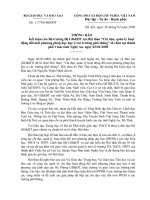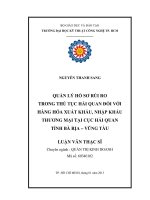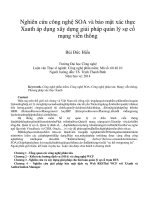Hoi thao 28 08 quan ly su co rui ro trong y te mr karim (EN)
Bạn đang xem bản rút gọn của tài liệu. Xem và tải ngay bản đầy đủ của tài liệu tại đây (3.8 MB, 34 trang )
Page 1
Strategic Conversation
Management
Risk
10
Healthcare
10
10
Page 2
Page 3
1st Singapore Standard hospital in Vietnam
Page 4
1st Singapore Standard hospital in Vietnam
Doctors of VietnamGermany Hospital
operated the wrong leg!
The operation took place in
the evening of July 19,
instead of surgical treatment
for paralysis in the left leg of
the male patient, the doctor in
the Department of Orthopedic
3 of Vietnam-Germany
Hospital operated the right
left.
Page 5
1st Singapore Standard hospital in Vietnam
Strategic Conversation
• Moved from the Age of Knowledge to the Age of Intelligence
• The 21st century started as a century of uncertainty
• Hospital Risk Management: Why flags matter
The impossible made possible
Clem Sunter
Success Stories
Nelson Mandela was the first black
President of South Africa. During
apartheid, he was imprisoned for 27
years. From prison, many believe he
lead the ANC and drove the successful
movement to stop apartheid. He was
released from prison in 1990 and was
President by 1994.
Do you think that transition occurred
by chance?
Most do not. Most believe the
transition of South Africa to majority
rule was carefully choreographed
Page 6
1st Singapore Standard hospital in Vietnam
Strategic Conversation
Strategy, the aim of the healthcare business, should not change that often, while
tactics to stay on course will vary according to how the game evolves.
Seven (7) principles of strategy
Page 7
1. Strategy is direction. Tactics are how to get there.
2. Strategy formulated without first consulting the context will probably end up
being bad strategy.
3. Strategy is as much about ruling in potential paths that fit our scope as ruling
out others that don't.
4. Good strategy can be turned into bad strategy by a future change in the
context. Scenarios are a way of exploring alternative futures, which might
necessitate a change in strategy.
5. Bad tactics can destroy good strategy, but no tactic can rescue bad strategy.
6. Good strategy has a greater chance of being converted into good results if
tactics are accompanied by a set of measurable outcomes to which people
can aspire.
7. Above all, strategy is about understanding what we do and don't control, and
what is certain and uncertain about the future - and knowing when to change
direction to avert unintended, and possibly tragic, consequences.
1st Singapore Standard hospital in Vietnam
10 steps to Future Risk Management Program
Two questions healthcare leaders
ask before committing to action:
1. what do we and do we not
control?
2. What is certain and uncertain
about the future?
Many healthcare leaders have
constructed an ingenious matrix
around these questions, which
assists to identify the rules of the
game; assess the key uncertainties;
paint scenarios; evaluate realistic
options; and thereby make effective
decisions. Essentially the matrix will
give us the edge:
Page 8
1st Singapore Standard hospital in Vietnam
1
1. Hospital Risk No. 1: Medication Errors: A 2006 report from the
Institute of Medicine estimated that every year, there are 450,000
injuries resulting from medication errors in hospitals, and perhaps
many more that are unreported.
2. Hospital Risk No. 2: MRSA and Other Hospital-Acquired
Infections: According to the CDC, there are 1.7 million health-careassociated infections every year; 22% are infections of surgical
wounds. Even more -- 32% -- are urinary tract infections.
3. Hospital Risk No. 3: Pneumonia
4. Hospital Risk No. 4: Deep Vein Thrombosis (DVT)
5. Hospital Risk No. 5: Bleeding After Surgery
6. Hospital Risk No. 6: Anesthesia Complications
7. Speaking Up Lowers Hospital Risks
Page 9
1st Singapore Standard hospital in Vietnam
1
Questions to ask:
1.
2.
3.
4.
Page 10
Is my hospital prepared to respond to these events?
Does my hospital need to be prepared anyway?
What are our priorities?
Have we done our risk assessment?
1st Singapore Standard hospital in Vietnam
1
Major Risk Types:
1. Facility and safety risk
2. Operational risk
3. Occupational health risk
4. Financial risk
5. Communication risk
6. Security risk
7. Patient safety risk
8. Many more
Page 11
Few examples:
1. Communication failure
2. Wrong patient identification
3. Patient fall
4. Nosocomial infection
5. Incident reporting
6. Complaint reporting
7. Staff grievance
1st Singapore Standard hospital in Vietnam
1
Reactive Method
Risk reporting system:
1. Incident reporting
2. Patient complaint and
3. Staff grievance
Proactive Method
1. Failure Mood Effective Analysis (FMEA): Proactively perform
risk assessments by scoring ‘Risk Priority Numbers (RPN)’. The Risk Priority
Number is a mathematical product of the numerical Severity, Probability, and
Detection ratings: RPN = (Severity) x (Probability) x (Detection)
The RPN is used to prioritize services than require additional quality planning
or action.
2. Hospital Round
Page 12
1st Singapore Standard hospital in Vietnam
1
RPN: Severity Score
Page 13
1st Singapore Standard hospital in Vietnam
1
RPN: Probability Score
Page 14
1st Singapore Standard hospital in Vietnam
1
RPN: Detection Score
Page 15
1st Singapore Standard hospital in Vietnam
1
S
E
V
What is In what ways
the does the key
process input go
step/ wrong?
Input
under
investiga
tion?
What is the
impact on the
key output
variables
(customer
requirements)
or internal
requirements
?
Page 16
Potential
Causes
What causes
the key input
to go wrong?
P
R
O
Current
Controls
What are the
existing
controls that
prevent either
the cause or
the failure
mode?
D
E
T
How well can you detect the
cause/failure before next step?
Potential
Failure
Effects
How often does cause or failure
mode occur?
Process
Potential
Step/Inp
Failure Mode
ut
How severe is the effect to
the customer?
Risk Priority Numbers (RPN)
R Actions
P Recomme Resp.
nded
N
Actions
Taken
What are Who is What actions
the actions respon have been
for
sible taken and
reducing for the
date
the RPN. recom completed?
Should mende
have
d
actions action?
only on
high RPN's
or easy
fixes.
1st Singapore Standard hospital in Vietnam
R
S
E
V
R
P
R
O
R
D
E
T
R
R
P
N
2
1. Currently, the Risk Management program in the hospital is fragmented
and not organized.
2. MOH 83 KPIs to monitor QA program in the hospital. But it is limited to
certain standards without proper explanation.
3. Huge scope for establishing Risk Management program with holistic
approach and establish a separate department to overview the Risk of
the hospital.
Page 17
1st Singapore Standard hospital in Vietnam
2
1. Where is there Scope to extend the field into new risk management
program, or extend within QA activities?
2. Should you change your strategy totally, because the current ground
has become unattractive to staff?
Page 18
1st Singapore Standard hospital in Vietnam
3
Page 19
1st Singapore Standard hospital in Vietnam
3
1. identify and develop the organizational
structure to promote Risk management
program within hospital.
2. Who are the Players (internally or
externally) who can significantly affect the
outcome of the Risk Management Game
we have chosen?
3. Who are the ones for us, who want to win;
who are those against us, who want to
lose; who are neutral and liable to swing
either way?
Page 20
Quick Observation:
we arehospital
‘Reactive’
1st Singapore Standard
in Vietnamrather than ‘Proactive’
4
This Risk Management program needs to create rules of the
game to win. Fundamentally, there are three rules:
1. Descriptive Rules (those that give us
license to operate),
2. Normative Rules (those that cover
ethics, corporate governance, the
environment, health, safety and
corporate social investment), and
3. Aspirational Rules (those that will give
our organization the edge to win the
Game) and influence whole hospital!
Page 21
1st Singapore Standard hospital in Vietnam
5
1. What are the major uncertainties surrounding your risk management
program that keep you up at night?
2. Which are internal (usually controllable)?
3. Which are external (sometimes uncontrollable)?
Page 22
1st Singapore Standard hospital in Vietnam
5
1. Will they, in your opinion, affect
the outcome of the Game?
2. Can you or your organization
influence these uncertainties or
will you just have to deal with
them?
3. Follow the American Society for
Healthcare Risk Management,
ASHRM
Page 23
1st Singapore Standard hospital in Vietnam
6
•
What are the two principle variables affecting your risk
management program from which you can construct a
Best-Case Scenario, a Worst-Case Scenario and two
Intermediate Case Scenarios?
An example might look like this, depending on the
State of the program and State of the Acceptance:
1.
2.
3.
4.
Page 24
Strong Program/High Acceptance (Best)
Strong Program/Low Acceptance (Intermediate);
High Acceptance/Weak Program (Intermediate);
Low Acceptance/Weak Program (Worst).
1st Singapore Standard hospital in Vietnam
7
SWOT – The “As Is” to the “Should Be” –
1. How do determine strengths and weakness inside our organization?
2. How do see opportunities and threat from outside our organization?
3. How do create Action Plan and monitor progress?
Page 25
•
What are your internal Strengths and
Weaknesses?
•
Consider this question in terms of
your: Customers, Products &
Services, Human Resources,
Support Services, Administrative
Management System and Financial
Management System)
1st Singapore Standard hospital in Vietnam









